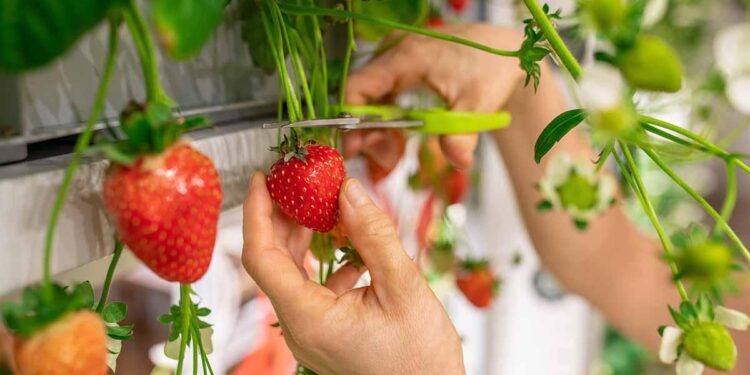The Netherlands has witnessed a remarkable surge in strawberry production over the past decade and a half, with the harvest volume doubling despite a notable reduction in cultivation acreage. This unexpected growth highlights advancements in agricultural technology and improved cultivation techniques that have enabled Dutch growers to maximize yield on smaller plots of land. As strawberries continue to gain popularity both domestically and internationally, the country’s efficient and innovative approach sets a compelling example for sustainable fruit farming in a competitive market.
Strawberry Yields Surge Amid Shrinking Farmland in the Netherlands
In an impressive feat of agricultural innovation, Dutch strawberry producers have managed to double their harvest over the past 15 years even as the total farmland dedicated to strawberries has shrunk significantly. This remarkable growth is largely attributed to the adoption of cutting-edge horticultural techniques such as vertical farming, optimized greenhouse environments, and precision irrigation systems. Farmers are now able to maximize output per square meter, maintaining fruit quality while reducing resource consumption.
Key factors contributing to this productivity surge include:
- Advanced soil management and nutrient delivery systems
- Climate-controlled greenhouses enabling year-round harvests
- Improved strawberry cultivars tailored for higher yields and disease resistance
- Automation and smart farm technologies reducing labor costs and errors
| Year | Acreage (ha) | Yield (tons/ha) | Total Production (tons) |
|---|---|---|---|
| 2008 | 1,200 | 10 | 12,000 |
| 2018 | 950 | 18 | 17,100 |
| 2023 | 780 | 25 | 19,500 |
Innovative Cultivation Techniques Drive Production Growth
Advanced cultivation methods have significantly contributed to the remarkable surge in strawberry yields across the Netherlands. Growers have embraced precision agriculture tools, optimizing resource use while enhancing fruit quality. Innovations such as climate-controlled greenhouses, integrated pest management, and automated irrigation systems have minimized crop stress and maximized productivity. These techniques allow for year-round growing cycles, enabling farmers to capitalize on improved growing conditions without expanding their land footprint.
Additionally, the integration of data analytics and sensor technology supports informed decision-making, streamlining the cultivation process. The adoption of vertical farming and substrate systems has made efficient use of space and nutrients, leading to healthier plants and higher yields. Below is an overview of key cultivation advancements shaping today’s Dutch strawberry production:
- Climate-controlled environments: regulated temperature and humidity
- Automated irrigation: precise water delivery based on plant needs
- Integrated pest management: reduced pesticide reliance
- Vertical farming techniques: space-efficient planting
- Data-driven monitoring: real-time crop health insights
| Technique | Impact on Yield | Environmental Benefit |
|---|---|---|
| Climate Control | +25% | Energy-efficient heating |
| Automated Irrigation | +15% | Water conservation |
| Vertical Planting | +20% | Reduced land use |
Recommendations for Sustainable Expansion and Resource Management
To sustain the remarkable growth in strawberry production while managing limited land resources, it is essential to prioritize innovative growing techniques such as vertical farming and hydroponic systems. These approaches not only maximize yield per square meter but also reduce water consumption and pesticide use, aligning with eco-friendly agricultural standards. Additionally, encouraging collaboration between growers and research institutes can accelerate the adoption of precision agriculture tools, optimizing fertilizer application and pest control based on real-time data analytics.
Resource efficiency must also extend beyond the farm. Implementing closed-loop systems for water recirculation and energy recovery from residual biomass can significantly reduce the environmental footprint of the strawberry production chain. Below is a comparison of potential resource savings using emerging sustainable practices versus conventional methods:
| Practice | Water Use Reduction | Energy Savings | Yield Impact |
|---|---|---|---|
| Hydroponics | Up to 70% | Medium | +30% |
| Vertical Farming | Up to 80% | High | +40% |
| Conventional Soil-based | Baseline | Baseline | Baseline |
In Retrospect
The remarkable increase in strawberry production in the Netherlands, achieved despite a significant reduction in cultivation area, underscores the impact of innovation and efficiency within the horticultural sector. As growers continue to adopt advanced techniques and sustainable practices, the Dutch strawberry harvest stands as a testament to the industry’s resilience and adaptability. Moving forward, these trends may serve as a model for other regions facing similar challenges of limited land availability and growing demand.
















